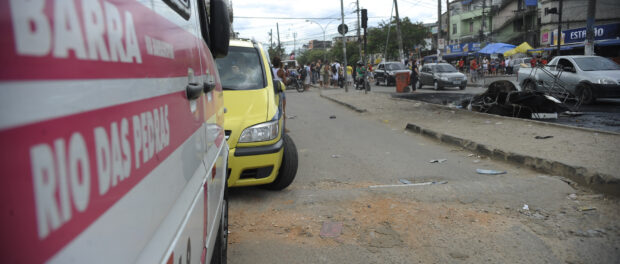
The subject of militias has grown recently in local and international media coverage of Rio, amid concerns of lack of democracy and coercive votes in the controlled areas during this election season. While these concerns are genuine, an OsteRio conference held by the Institute for the Study of Labor and Society (IETS), ‘Militias: a growing power in Rio de Janeiro,’ on September 29 presents how the control and profit of the militias goes deeper than electoral power, affecting residents on a daily basis.
In a talk led by researcher Ignacio Cano, from the Violence Analysis Laboratory at Rio de Janeiro’s State University, and journalists Sérgio Ramalho and Elenilce Bottari, the history of the militias was discussed, with final thoughts on solutions for the situation. While Cano has been involved in militia research since 2008, Ramalho and Bottari have produced several reports on the growth of militias over the years for the newspaper O Globo.
The use of the term ‘militia’ to describe groups of ‘armed off-duty state agents’ who abuse their official access to arms to control primarily vulnerable, low-income areas of the city began in 2006. The initial premise that allowed these groups to prosper was the offering of “protection services” for a profit. Today, the people who live in these communities are obligated to pay for the militia’s protection service, along with a range of additional living fees.
According to Cano’s research paper Hidden: The Evolution of Militias in Rio de Janeiro (2008-2011), militias are defined by five criteria:
1) Micro-territorial control;
2) The profit motive;
3) Coercive force against residents and business owners;
4) A narrative of liberation from the drug trafficking gangs;
5) The participation of public armed agents of the state (this can include retired or active policemen, correctional officers, firemen and a plethora of militarily trained state agents) as well as private security personnel.
Ramalho simplifies: “the militias are Rio de Janeiro’s mafia,” much more sophisticated than other organized groups like drug traffickers or ‘extermination groups.’
The phenomenon was initially accepted and even supported by many political leaders across Rio de Janeiro. The militias in some communities began as a ‘neighborhood watch’ system that sought to end drug trafficking, a problem that has always been centralized in Rio de Janeiro politics. In other places and increasingly frequently, however, militias were centralized, run by gang leaders from outside the communities who would engage in extortion and intimidation.
This image quickly changed in 2008 when three reporters from the O Dia newspaper were kidnapped and tortured by a militia in the community of Batan in Realengo, West Zone. The widespread reaction to these crimes forced militias to become more discrete.
A Change in Operation
After a state investigation and several arrests for the kidnapping and torture of O Dia journalists, militias changed their modus operandi to a more underground demeanor. Where the drug trafficking gangs are happy to display their assault weapons, the already discrete militias became even less ostentatious in an effort to drive media attention away.
They also stopped controlling the ins and outs of favelas. Previously, permission was required by outsiders who wanted to enter the favela. This is no longer necessary, although the territories are under surveillance at all times. Cano warned that “they still kill whoever they want.”
This underground operation results in constant terror in the communities. The level of intimidation is much higher, Cano explained, “because no one knows who is really in charge.” He also revealed that his research interviewees were paranoid about their calls being recorded and their text messages being intercepted.
A Journalistic Perspective
Sergio Ramalho and Elenilce Bottari have been covering militias since they started proliferating in Rio. Their most recent findings reveal that despite the arrest of almost a thousand people in relation to militia activities, the groups keep growing in numbers and control 36 of 92 municipalities in Rio de Janeiro. This means that around 620,000 people are under the control of militias. These groups control “the selling of essential goods, transportation and the administration of housing projects.” A recent case of 1600 public housing units controlled by militias gained attention. The people in charge of collecting this money are young men–they are the base of the organization.
Although Cano said it’s “questionable” to measure the growth of militias by the number of controlled areas, Ramalho and Bottari’s work goes beyond counting the number of active militias. Ramalho told stories of people who pay three times more for food under the rule of militias, and revealed the proliferation of these groups in Minha Casa Minha Vida (MCMV) housing projects is so common that people call it “My Militia, My Life.” Often, the administrators of the buildings are part of the scheme, enforcing the control and extra militia fees as soon as new families move in. Essential services of informal transportation like moto-taxis and kombis are also exploited, with drivers having to pay an extra fee every week.
“I would say the West Zone is completely in the hands of the militias,” revealed Ramalho.
Ramalho and Bottari also confirmed there is less ‘ostentation’ in the actions of militias but that some of the groups have started investing in drug trafficking instead of sticking to their initial ‘vigilante’ narrative. In the Rio das Pedras favela, for example, where militias required payment to keep addicts away, marijuana and cocaine can be bought and used without repression from the control groups. Agreements between drug trafficking gangs and militias are common. Ramalho also says many of his interviewees prefer to be under the rule of militias than that of drug gangs–presumably because of the higher level of organization, premise of protection and the presence of an authority where the state has failed to be present.
A Disappointing Lack of Action
Despite its continued growth and increasingly illicit activities, all three speakers maintain there is little being done to contain militias across Rio. Cano says “there are no strategies in place to combat the militias and take back those areas” because the state’s armed forces are all concentrated on combating the drug trafficking gangs. And the involvement of state officials in militia activity, largely off duty police, is possibly the most significant obstacle to tackling this frightening reality lived by so many Rio citizens.
Although almost a thousand people have been arrested since the torture of the O Dia journalists in 2008, Ramalho says “the militia structure is already present, so it just forms back again” and that many arrested leaders still coordinate with their militia groups from prison.
While Rio’s public security policy is currently focused on drug gangs, re-directing some of these forces towards militias is necessary, though it would not be enough to contain the phenomenon. Militia-focused investigations are vital to uncover the extent of militias and target their kingpins. There are also a range of supplementary ways to take back control such as regulating moto-taxis and vans, thus protecting the drivers from being forced to pay fees to militia leaders. It was also suggested by Cano that “private [phone, cable TV and electricity] companies must offer discounted prices to communities to avoid the hiring of militias” that often offer a cheaper price to struggling families, trapping them into their control. Another suggestion given was protecting the privacy of MCMV public housing beneficiaries, whose information is open to the public, thus facilitating the attainment of information about vulnerable families to militias.

